|
RUGGEDBOOK Rugged Tablet PC-751
Samwell's 2nd generation rugged 10.4-inch tablet for on-the-go mobile users powered by Intel "Bay Trail" dual-core processor technology
(by Conrad H. Blickenstorfer, with photography by Carol Cotton)
When Samwell introduced the PC-750 a couple of years ago, the goal was to present a lighter, handier alternative for situations where a full-size tablet computer was too big and heavy. In essence, the platform was the tablet equivalent of a netbook — smaller, lighter and less expensive than a full-size laptop. Netbooks are gone now, but the PC-750 line remains relevant to the enterprise and vertical markets as a Windows-based, more rugged, and much better connected alternative to consumer media tablets.
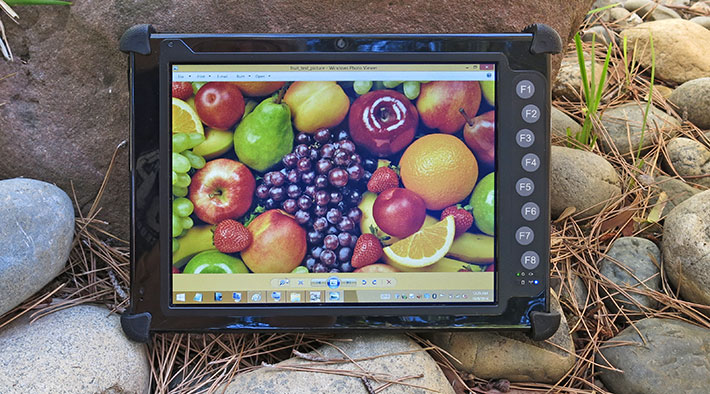
In response, Samwell introduced the PC-751, a second generation version of the platform that's now based on Intel's Bay Trail processor technology.
What is the Ruggedbook 751, and where does it fit in? At a time where most manufacturers of rugged computing equipment still wonder how to stem the push of inexpensive consumer tablets in a case with something that's just as slick but more durable, the Ruggedbook 751 is simply a rugged Tablet PC, nothing more and nothing less. It's over an inch thick (and more with its protective bumpers), and weighs almost three pounds, more than twice as much as a consumer market tablet. It is not a high-tech fashion statement to impress the crowds at Starbucks. It is a rugged tablet tool for jobs out there in the field. One that runs Windows (ours came with Windows 8.1), has plenty of onboard ports, and just generally extends enterprise Windows functionality out into the field.
Taking a look at the Ruggedbook PC-751
Unlike many of the industrial and enterprise market tablets that have been introduced as of late, the Ruggedbook PC-751, doesn't seek to be a more protected version of an iPad or a Samsung tablet. Even in its second generation, it remains a modern interpretation of a traditional Tablet PC. It measures 10.8 x 7.8 inches, which is quite compact. Its 10.4-inch display is iPad-class and looks large and inviting. And unlike media tablets that must make due with one small micro-USB port, it has a full complement of I/O ports, and they are all full size.
The design is purposeful rather than fancy. There's no chrome or stylish elements here, except perhaps part of the front housing that is needlessly glossy for no apparent reason. The PC-751 remains an innocuous tablet with boxy protective bumpers on each corner to ward off harm. There is no keypad and there are no hardware controls other than a number of large membrane pushbuttons, labelled F1 through F8, along the right side of the display.
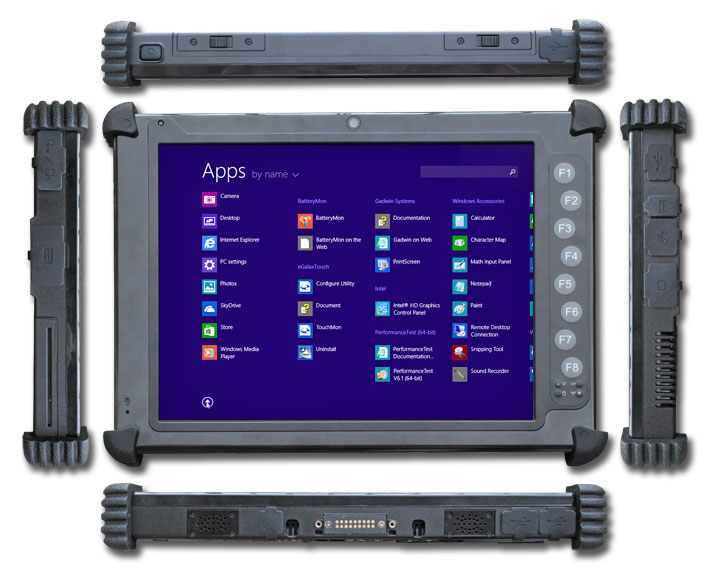
Looking at the PC-751 tablet from all sides, there are ports underneath individual protective rubber plugs on the left and right and top, and a surface-mount docking connector and two speakers at the bottom.
Note that each of the many ports has its own separate protective cover. The covers are implemented as soft rubber plugs that can be pried open and resealed fairly easily. Each is attached to the housing via a thin rubber hinge.
The 751 has rubber bumpers on each of its four corners. They are screwed on and can easily be removed or replaced. They are not organically integrated into the design, and it's perhaps not the most attractive solution. Prominent rubber bumpers, however, are a simple and very effective way to add a considerable degree of protection to a tablet. Customers who will exclusively use the 751 in an office may want to remove them for a sleeker look, but anyone taking this machine on the job and in the field should leave them on. The bumpers, incidentally, are not just rubber; it's rubber on top of metal.
Samwell may offer different I/O configurations. Our review unit included the following ports:
On the right side:
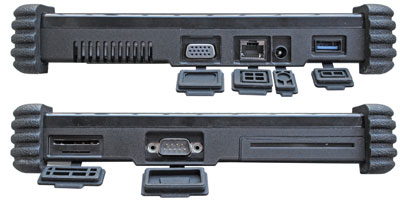
- VGA 15-pin
- RJ45 LAN
- Power
- USB 3.0
On the left side:
- SDHC Card reader
- SIM Card reader
- DB9 RS232 Serial
- Device Bay (ours had a second battery)
On the bottom side:
- 2 speakers
- Microphone and headphone jack
- Docking connector

- 2 x USB 3.0)
On the top-right is an additional USB port, bringing the total to four full-size USB 3.0 ports. The documentation actually claims just one USB 3.0 port and three of the older 2.0 variety, but on our sample unit all four USB ports were blue, which usually means USB 3.0.
The one concern I have about the design is that the various I/O openings completely rely on the protective rubber plugs for sealing, i.e. the connectors behind the protective plugs do not have additional sealing. The plugs fit very well and they are replaceable, but you have to firmly push them into place to get a reliable seal, and that may not always be easy when you wear gloves or when it's cold out there in the field.
Design and construction
In terms of construction, the Ruggedbook PC-751 consists of plastic upper and lower halves, with the LCD mounted onto the upper, and the circuit board(s) onto the lower. A small rubber o-ring runs around the entire perimeter of the housing and seals the two halves together. A metal backplate covers the inside of the LCD and provides extra rigidity and strength to the assembly.
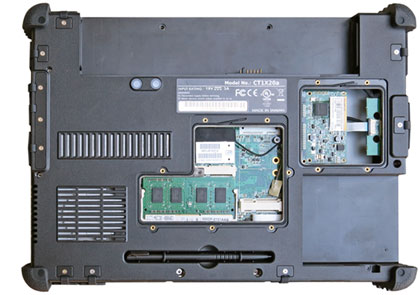 There is no fan, but there is a finned metal heat exchanger that conducts heat away from the processor and chipset to the outside. The heat exchanger sits beneath a slotted part of the bottom, which may lead casual observers lead to believe that liquids could enter the tablet that way. That's not so; the heat exchanger is sealed against the inside of the bottom cover. The same, by the way, applies to the unit's two speakers. They have slotted covers, but are actually sitting in compartments molded into the housing, and sealed to the inside of the housing. There is no fan, but there is a finned metal heat exchanger that conducts heat away from the processor and chipset to the outside. The heat exchanger sits beneath a slotted part of the bottom, which may lead casual observers lead to believe that liquids could enter the tablet that way. That's not so; the heat exchanger is sealed against the inside of the bottom cover. The same, by the way, applies to the unit's two speakers. They have slotted covers, but are actually sitting in compartments molded into the housing, and sealed to the inside of the housing.
The 751 offers easy access to its module compartments via two screwed-on metal covers. Beneath one of them is the SATA port with the SSD. The other provides access to the single RAM slot, and two PCIe connectors, one mini (used by the WiFi module) and the other full-size. Both of these covers are sealed via a thin rubber seal that sits in a groove. It can easily be replaced, but also easily pops out, so whenever the service doors are opened, make sure the seals are properly in place when screwing the covers back on.
The main battery is a slender 14.8V 1,800mAH 27.8 watt-hour Li-Ion pack. It slides into the back of the tablet, netbook-style. The battery compartment itself isn't sealed, but there is a seal around the connector block. The battery is securely held in place via two friction sliders.
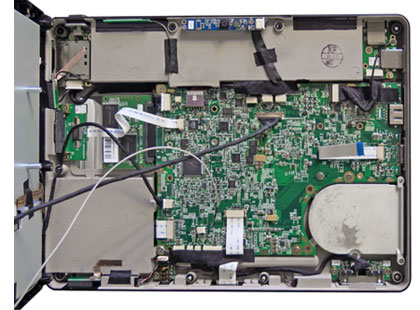 The motherboard, which was clearly designed specifically for this tablet, is fairly large and takes up about 2/3 of the interior area. The motherboard, which was clearly designed specifically for this tablet, is fairly large and takes up about 2/3 of the interior area.
If you wonder how this tablet can have ports along all four sides of the device, it's because, in addition to a few edge-mounted ports (power, RJ45, VGA) there is a number of separate, small I/O blocks.
There are two that contain two USB ports each, another one contains two expansion slots, one an RS232 DB9 serial port, and even the audio jack has its separate board. This approach allows Samwell to easily customize device I/O and configure it to customer requests.
The 751 has a "black box" device bay that measures about 2.5 x 3 inches and is half an inch thick. This can be used for various additional functionality. Our "black box" contained the secondary battery.
Overall, this is a rather complex design, but service should not be very difficult.
Storage
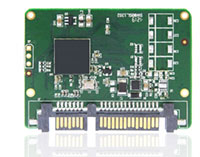 Unlike earlier Ruggedbook models that came standard with rotating hard disks and may have offered solid state storage as an option, our PC-751 evaluation unit came with a 64GB SSD, with SSDs from 32GB to 128GB available. There is no legacy hard disk option. Unlike earlier Ruggedbook models that came standard with rotating hard disks and may have offered solid state storage as an option, our PC-751 evaluation unit came with a 64GB SSD, with SSDs from 32GB to 128GB available. There is no legacy hard disk option.
That makes perfect sense in a rugged device, as hard disks with their spinning platters have always been among the subsystems most prone to damage. Solid state storage remains more expensive per GB and SSDs usually come with lower capacities than hard disks. But SSD prices have come down a lot, and storage can always be augmented with inexpensive SD Cards.
As is, the SSD in our PC-751 is a Team Group Industrial SSM (see here) with a SATA III 6Gb/s interface that uses the same physical 7+15-pin connector as all standard SATA ports.
Powered by Intel Bay Trail
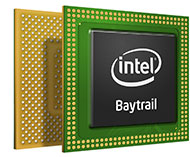 Processing power now no longer comes from an Intel Atom N2600, but from an E3825 system-on-chip that's part of Intel's next-gen "Bay Trail" platform which employs 22nm process technology and represents the first major advance in Atom microprocessor architecture since the platform arrived a few years ago. "Bay Trail," however, is not just a new gen of Atom processors; instead, it's a large family of single, dual, and quad processor chips optimized for various types of devices. And not all Bay Trail processors use Intel's "Atom" brand; higher end versions targeting notebooks and desktops carry Intel's "Celeron" and even "Pentium" brand names.
Processing power now no longer comes from an Intel Atom N2600, but from an E3825 system-on-chip that's part of Intel's next-gen "Bay Trail" platform which employs 22nm process technology and represents the first major advance in Atom microprocessor architecture since the platform arrived a few years ago. "Bay Trail," however, is not just a new gen of Atom processors; instead, it's a large family of single, dual, and quad processor chips optimized for various types of devices. And not all Bay Trail processors use Intel's "Atom" brand; higher end versions targeting notebooks and desktops carry Intel's "Celeron" and even "Pentium" brand names.
Further, for the first time, an Intel Atom microprocessor architecture is paired with genuine Intel graphics. The graphics cores integrated into Bay Trail systems are of the same HD 4000 architecture and variety as those used in Intel's 3rd generation "Ivy Bridge" processors, albeit with fewer execution units (four instead of several times that number) and lower clock speeds. Still, the new graphics support most of the same APIs and features, including DirectX 11, OpenGL 4.0, OpenCL 1.2, and the chips can inherently support dual displays up to 2560 × 1440 (or 1080p over HDMI). Better yet, there's also turbo boost in some processors, and the clever power-saving "active idle" feature from Haswell core processors is there as well.
Some may wonder why Samwell decided to switch chips. The N2600 was a good and competent performer, and at first sight the E3825 does not seem to be much of an upgrade. Both are dual-core processors, but the older N2600 had four threads versus the E3825's two. Clock speed of the E3825 is lower — 1.33GHz vs. 1.6GHz — but the new chip's thermal design power is actually higher (6 watts vs. 3.5 watts). But the E3825's Intel HD graphics seem a genuine advantage and, perhaps most importantly, the new chip can support up to 8GB of RAM instead of just 2GB, which by now is marginal for Windows, and especially 8.1. And the RAM is of the more efficient DDR3L variety, and faster as well.
Performance
Intel's Atom processors have traditionally played a rather unenviable role in the overall Intel processor lineup. Designed to be inexpensive and draw as little power as possible, they didn't offer anywhere near Core processor performance and also lacked most of their features. The Atom N2600 was really the first widely used Atom processor that offered acceptable performance in tablets. This is likely one of the reasons why Intel is now using the Celeron and Pentium brand names for higher-end Bay Trail processors, and why most manufacturers, including Samwell, omit the "Atom" name entirely and simply refer to the chip as the E3825.
To see how the E3825 fares in the PC-751, we used Passmark Software's PerformanceTest 6.1 that runs about 30 tests covering CPU, 2D graphics, 3D graphics, memory, and disk and then computes scores for each category and an overall PassMark score. We also ran our secondary standard benchmark suit, CrystalMark. For comparison, we're listing RuggedPCReview benchmark results for the 751's PC-750 predecessor, Samwell's tried-and-true SR820 tablet, as well as three competitor tablets in the 10-inch class that use the Atom N2600 or N2800 processor. The results are as follows:
|
Samwell Ruggedbook PC-751 Benchmarks and Comparisons
|
|
PERFORMANCE COMPARISON
|
Ruggedbook
|
Ruggedbook
|
Ruggedbook
|
DAP Technologies
|
GammaTech
|
Handheld Group
|
|
Model
|
PC-751
|
PC-750
|
SR820
|
M1010
|
CA10
|
Algiz 10X
|
|
Processor Type
|
Intel Bay Trail
|
Intel Atom
|
Intel Atom
|
Intel Atom
|
Intel Atom
|
Intel Atom
|
|
Processor Type: Intel
|
E3825
|
N2600
|
Z530
|
N2600
|
N2600
|
N2800
|
|
Thermal Design Power (TDP)
|
6.0 watts
|
3.5 watts
|
3.5 watts
|
3.5 watts
|
3.5 watts
|
3.5 watts
|
|
CPU Clcok
|
1.33GHz
|
1.60GHz
|
1.60GHz
|
1.60GHz
|
1.60GHz
|
1.86GHz
|
|
CPU Mark
|
572.2
|
482.8
|
248.7
|
443.4
|
463.5
|
538.0
|
|
2D Graphics Mark
|
84.4
|
64.1
|
101.8
|
39.0
|
39.2
|
39.0
|
|
Memory Mark
|
238.3
|
223.1
|
222.5
|
190.2
|
206.6
|
264.8
|
|
Disk Mark
|
379.7
|
513.6
|
218.6
|
539.3
|
1,128.4
|
1,733.2
|
|
3D Graphics Mark
|
91.2
|
82.6
|
18.6
|
41.1
|
66.3
|
80.1
|
|
Overall PassMark
|
296.1
|
292.1
|
167.4
|
266.4
|
396.4
|
555.2
|
|
ALU
|
9,158
|
10,744
|
5,272
|
10,261
|
10,719
|
12,191
|
|
FPU
|
7,504
|
8,298
|
4,571
|
7,822
|
8,073
|
9,374
|
|
MEM
|
12,170
|
8,628
|
3,969
|
6,790
|
7,099
|
8,654
|
|
HDD
|
13,828
|
12,398
|
3,678
|
15,110
|
21,856
|
27,789
|
|
GDI
|
2,991
|
1,479
|
2,806
|
1,264
|
1,372
|
1,683
|
|
D2D
|
2,472
|
600
|
1,048
|
152
|
532
|
689
|
|
OGL
|
2,050
|
7,193
|
346
|
6,749
|
7,114
|
8,841
|
|
Overall CrystalMark
|
50,173
|
49,340
|
21,690
|
48,148
|
56,719
|
69,221
|
As usual, the benchmark results are a bit confusing. Overall, the PC-751 scored just a tad higher than the PC-750 it replaces, but significantly higher than the Atom Z530-powered Ruggedbook SR820.
In general, new generations of existing platforms usually get significant processor upgrades, and that's also generally the case with tech updates. In this case, the move from the "Cedar Trail" N2600 to the "Bay Trail" E3825 seems almost a lateral move, what with the new chip running at a lower clock speed, and delivering about the same overall performance. There's no doubt that the Bay Trail chip's support of faster DDR3L memory and significantly more sophisticated graphics make a noticeable difference in everyday use, but we'd have liked to see a bigger step forward.
 When looking at the benchmark results, there is one hardware area where there are very large differences in performance, and that's disk. In virtually every Atom system benchmark we've ever run, SSD trumps rotating media by a large margin. Interestingly, we've also found very large benchmark performance differences between different types of SSDs. Here, while the PC-751's Team Group SSD module was much quicker than the hard disks used in older Ruggedbooks, Samwell left some bottom line performance on the table compared to the SSDs used in some other tablets. When looking at the benchmark results, there is one hardware area where there are very large differences in performance, and that's disk. In virtually every Atom system benchmark we've ever run, SSD trumps rotating media by a large margin. Interestingly, we've also found very large benchmark performance differences between different types of SSDs. Here, while the PC-751's Team Group SSD module was much quicker than the hard disks used in older Ruggedbooks, Samwell left some bottom line performance on the table compared to the SSDs used in some other tablets.
In real live usage, the Ruggedbook PC-751 feels quick and responsive enough for its intended jobs. We noticed that screen rotation is much quicker than on the PC-750 we had in our lab as well.
Power consumption
When Intel Atom processors first hit the market a few years ago, their two primary selling points were low cost and minuscule power consumption compared to high-end processors of the day. In the meantime, Atom thermal design power has been creeping upward, whereas Intel's Core processors have become ever more power-efficient. We now routinely see Intel Core-powered mobile devices that have lower minimal power draws than that of Atom-based devices. Where does the E3825-powered 751 stand in terms of power draw?
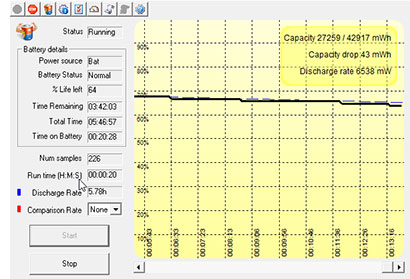 We used Passmark Software's BatteryMon power management benchmark utility to measure the 751's power draw under various operating conditions. We used Passmark Software's BatteryMon power management benchmark utility to measure the 751's power draw under various operating conditions.
With the Windows power options set to "Power Saver" and display brightness set to minimum, we saw an idle power draw of 6.5 watts. With display brightness set to maximum, it rose to 10.7 watts.
With the Windows power options set to "High Performance" and display brightness set to minimum, we saw an idle power draw of 6.9 watts. With display brightness set to maximum, it rose to 10.9 watts.
This means that at least when idling along, the Windows power settings have little impact on the PC-751's battery life.
We then placed a full load on the processor by running 1080p HD video in High Performance mode and with the backlight set to maximum. Amazingly, we still only saw 11.4 watts, which means the chip isn't working hard when decoding video. And the PC-751 played back the HD video smoothly without ever slowing dow. That's something early Atom-based tablets were completely unable to do.
It's interesting to compare Atom-and Core-based battery draw patterns. Whereas Intel Core-powered devices sometimes draw less than an Atom device while idling along, the full-load draw of Atom devices rarely exceeds twice the idle draw, and usually much less than that, whereas Core-powered devices can draw many times as much under load.
According to BatteryMon, the design capacity of battery 1 was 13.9 watt-hours and that of battery 2 27.1 watt-hours, for a total of 41 watt-hours. That would indicate a maximum battery life of about 6.3 hours without the system going to sleep.
Two integrated cameras
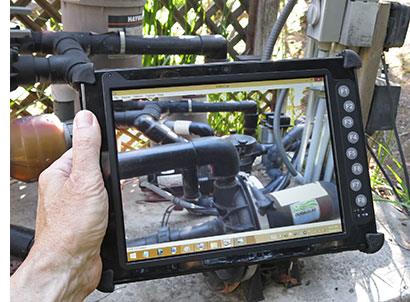 The PC-751 has two integrated cameras. The user-facing one is centered above the LCD, the rear-facing one is towards the upper left on the backside of the computer. The cameras can be accessed via the supplied VideoCap application by Unison Technology. The app allows selecting either the back or the front camera, and includes the usual common camera settings (i.e. image size, white balance, hue, saturation, sharpness, etc.). Both cameras can record stills and video, and as USB devices, both are accessible via other imaging applications. The PC-751 has two integrated cameras. The user-facing one is centered above the LCD, the rear-facing one is towards the upper left on the backside of the computer. The cameras can be accessed via the supplied VideoCap application by Unison Technology. The app allows selecting either the back or the front camera, and includes the usual common camera settings (i.e. image size, white balance, hue, saturation, sharpness, etc.). Both cameras can record stills and video, and as USB devices, both are accessible via other imaging applications.
In this day and age where most smartphones have very high resolution cameras that can also do full 1080p video, the PC-751's 2-megapixel cameras don't sound very exciting. Samwell offers a 5-megapixel option for the rear camera, and we'd definitely go for that. As is, the maximum resolution for each camera is 1600 x 1200 pixels for both stills and video. Still image quality is adequate and video capture speed is significantly faster than with the PC-750. Considering the high overall quality of the PC-751, as well as the current state of the art in smartphone and tablet cameras, we'd like to see better cameras.
That said, the cameras are good enough for rough project documentation images and video, but we would not rely on them for important details. Video playback, though, works flawlessly, even with full HD mp4 video.
Excellent 10.4-inch display
With tablets, more so than with desktops or laptops, display quality is everything. That's because while users generally sit down in front of a notebook or desktop display and look at it head-on, the viewing angle of tablets varies depending on how it's being held. Which means that a display that lets you look at the tablet from any angle without losing image quality and clarity is invaluable (and, in our opinion, pretty much mandatory).
The Ruggedbook PC-751 has such a display. You can look at it from any angle and the image remains perfectly viewable. No color shifts and aberrations, no changes in brightness or contrast. The high viewing quality of this display is especially amazing since resistive touch screens usually make displays less readable.
Samwell documentation doesn't specify what type of LCD it is, or who makes it. The Ruggedbook website does have a page where they explain their sunlight display technology (see here). It is pretty much the same approach used by most other rugged notebook and tablet makers, i.e. various means to minimize internal reflection so that the screen's backlight exceeds the amount of reflected light by as much as possible. That's done by minimizing the number of reflective surfaces in the many layers of a typical LCD assembly via bonding layers together and via polarizers and anti-reflective and anti-glare coatings.
How well does it work? Quite well. The pictures below show the PC-751 side by side with a 3rd generation Apple iPad. The iPad has a very good display and it's being used by tens or hundreds of millions outdoors every day. The iPad screen, though, is very glossy. The PC-751 display is noticeably less glossy, more like a semi-matte.
The first picture below shows the two tablets in bright sunshine outdoors in a semi-shaded area with plenty of contrasts. Both screes have their brightness cranked up to the max. What's instantly obvious is a glass-like refection on the iPad, whereas the Ruggedbook screen shows none. The glossy bezel does reflect, and we wish it weren't glossy. We then switched the position of the tablets to see how the PC-751 would handle the reflections that made the iPad unreadable. As you can see, the PC-751 display passed the test with flying colors.
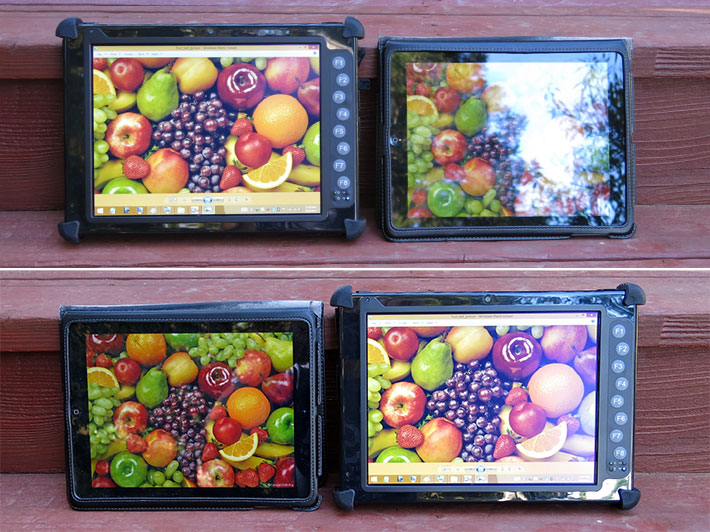
Viewed from an angle, the PC-751 display remains perfectly readable, and there are no reflections. The iPad's gloss screen reflect the surroundings, making it very hard to read.
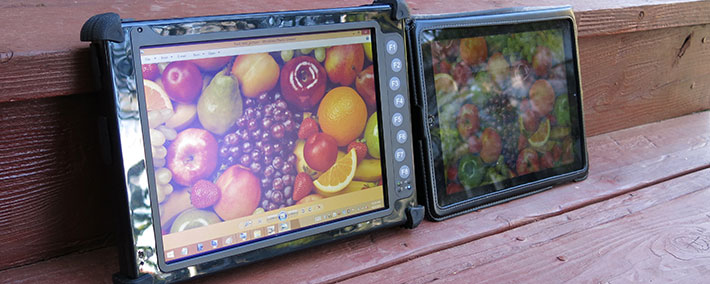
The picture below shows the two tablets from the other side. Here again, the iPad shows reflections whereas the PC-751 does not. That can make a huge difference in outdoor use.
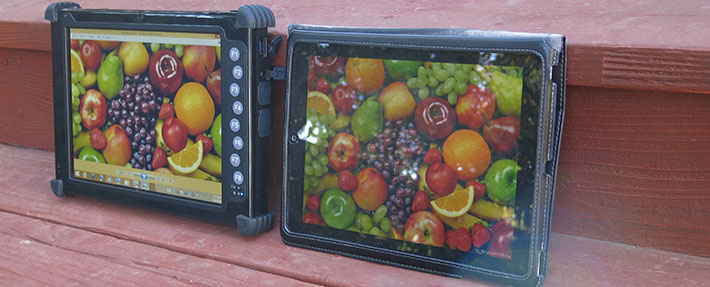
The final picture below shows the PC-751 laying flat on the ground outdoors, facing the sky. The left picture is in a shaded area, the right one a few inches away in direct sunshine. Obviously, the brighter the outdoor light, the less color and contrast you see, but the Samwell tablet does remarkably well.
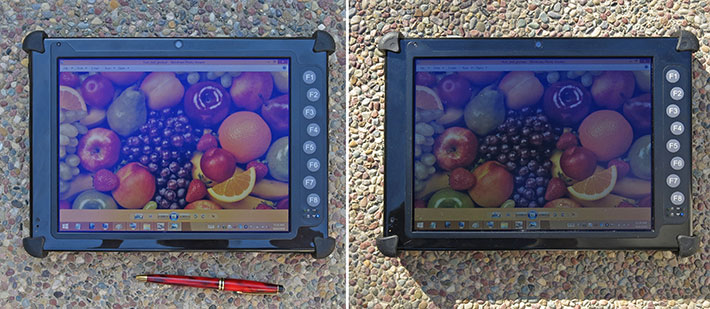
As far as display size and resolution go, 10.4 inches diagonal works very well with Microsoft Windows where smaller screens often struggle due to tiny onscreen controls, checkboxes, etc. The 1024 x 768 XGA display resolution also is very well suited for this size display. In this era of very high resolution "retina" tablet and smartphone displays, XGA no longer looks as sharp as it once did, but it's still adequate. Remember, this is the resolution and the size that worked just fine for tens of millions of first and second-gen iPads.
Digitizer
Unlike the vast majority of media tablets and smartphones that use projected capacitive touch, the PC-751 continues with a conventional resistive touch screen that can be operated with a stylus or finger. That means no effortless panning and pinching and zooming as you can do on capacitive touch screens, but it also means the 751 display can easily be used in the rain and with gloves on.
And unlike capacitive touch screens that can't easily be customized, the 751's resistive digitizer can be configured with the PenMount control panel that includes three settings screens.
Below you can see some of the configuration screens of the eGalaxTouch touch screen utility (click for a larger version):

Setting lets you select either mouse emulation mode or click-on-touch, enable a beep sound to occur on pen down or pen up (or both), and even set its frequency and duration. I am not sure how that would be used, but in noisy vehicle operation, having auditory feedback to confirm a touch operation may come in handy. You can also engage a cursor stabilizer to eliminate cursor jitter, and you can set how the digitizer should handle right clicks.
Edge compensation determines how the digitizer acts along the perimeter of the display where it is sometimes hard to accurately control the cursor.
Tools handles touch calibration using 4, 9, 16, or 25 points, with 25 points offering the maximum accuracy. In advanced mode you can opt to show calibration data.
Display lets you map the touch screen to the display in various ways, such as just the upper half, or a particular quarter, or even a completely customized area. This comes in handy for custom software applications.
The PC-751's resistive touch panel works well (and especially so with the stylus), and our evaluation unit included some of the traditional Microsoft Tablet PC tools and utilities, such as the Windows Journal ink notetaker or the handy Snipping Tool. The Microsoft Input Panel allows toggling between an onscreen keyboard and handwriting recognition. Resistive digitizers aren't a very good match for handwriting recognition, but it can be made to work, and you can doodle and sketch on the PC-751, something that wasn't available on the older PC-750.
As is, the PC-751's resistive digitizer works well for screen navigation, and it's immune to rain and moisture. However, just like Microsoft's Tablet PC software is optimized for an active digitizer, Windows 8.1 is optimized for capacitive touch. Resistive still has its place, but be aware of its pros and cons.
Numeric keypad and other data entry methods
The Ruggedbook PC-751 is a pure tablet and has neither a physical keyboard nor a lot of external physical controls. Whatever there is is lined up along the right side of the display, as shown in the image below. While Samwell's older SR820 tablet had labeled buttons for some of the typical tablet functions, on the PC-751 you get eight function buttons, each of which does double duty (simple press, or press and hold). This provides a total of sixteen software definable function buttons. That's a lot to remember, but it'd be easy to tack on a label overlay.

Our review tablet also came not only with the Windows 8.1 input panel, but also an older comprehensive onscreen QWERTY keyboard that can be toggled between the standard version and an extended version. The soft keyboard, however, pretty much requires the stylus and does not work well with touch (unless you use a fingernail).


For extended text entry, users can, of course, connect an external USB or Bluetooth keyboard.
Ruggedness
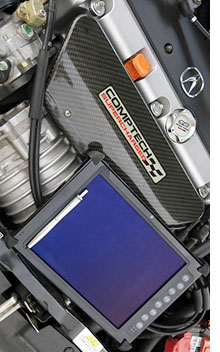 As the brand name implies, Samwell is in the business of making rugged computing technology. They consider the Ruggedbook PC-751 a fully rugged device. Its plastic housing is quite sturdy, and the design's toughness is enhanced by rubber bumpers on all corners that are actually steel caps with rubber on top. This makes them far more stable than rubber-only bumpers, and they attach very securely to the unit without the need of glue. The picture to the right shows one of the bumpers. As the brand name implies, Samwell is in the business of making rugged computing technology. They consider the Ruggedbook PC-751 a fully rugged device. Its plastic housing is quite sturdy, and the design's toughness is enhanced by rubber bumpers on all corners that are actually steel caps with rubber on top. This makes them far more stable than rubber-only bumpers, and they attach very securely to the unit without the need of glue. The picture to the right shows one of the bumpers.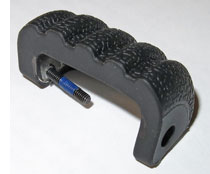
Samwell generally performs a variety of MIL-STD-810G testing, both in their inhouse lab and through external 3rd party testing labs. The PC-751 carries a 3-foot drop spec which indicates that it passed the MIL-STD 810G Method 516.6 Procedure VI "Drop" test that includes 26 drops to concrete on each face, edge and corner from 36 inches. The documentation does not indicate whether the device also passed mechanical shock, random vibration, temperature/humidity cycling as well as high/low temperature tests.
As far as sealing against the elements goes, the PC-751 carries an IP54 ingress protection rating where the "5" means the unit is protected against dust and guards against the accumulation of harmful deposits, and the "4" means the machine is protected against water spray from all directions, although limited ingress is permitted. While IP54 is certainly respectable, the overall construction of the machine looks like it could pass IP65 standards IF the I/O ports carried secondary sealing.
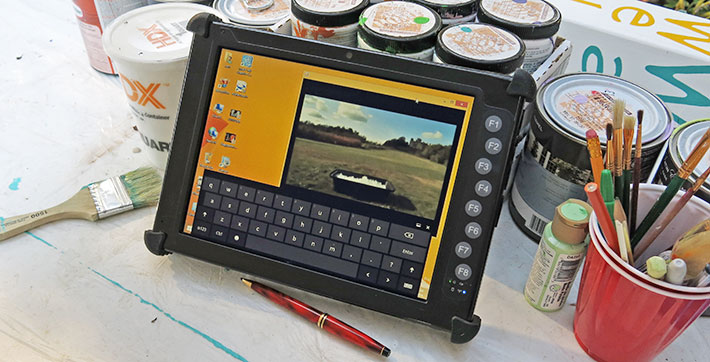
The standard operating temperature range is a very wide -4 to 122 degrees Fahrenheit (-20 to 50 degrees centigrade). That's wide enough to allow deployment in almost any geographical setting.
The pictures below show some of the typical independent ruggedness testing Samwell commissions to have performed on their units.

Summary
The Samwell Ruggedbook PC-751 provides full Windows 8.1 functionality in a rugged tablet form factor. Measuring just 10.8 x 7.8 x 1.1 inches and weighing just over three pounds, the PC-751 is considerably lighter than most traditional full-size rugged tablets. Its 10.4-inch touch screen with 1024 x 768 pixel XGA resolution offers enough space to run Windows comfortably. There is excellent wired connectivity on board, all the connectors are standard size, and there is a wealth of wireless functionality, and also dual integrated 2-megapixel cameras.
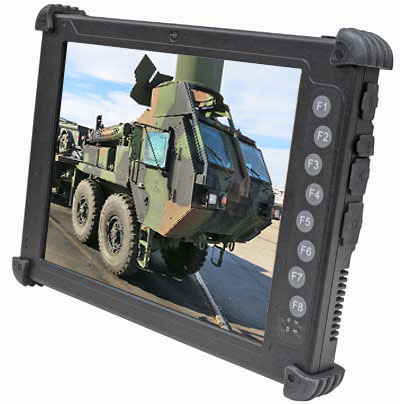 Powered by a dual-core 1.33GHz Intel "Bay Trail" E3825 processor, the PC-751 provides a good balance between performance and acceptably long battery life, and thanks to the low Thermal Design Power of the processor it does so without the need of a fan. Unlike the predecessor PC-750, the new PC-751 can easily handle multimedia, HD video playback, and it feels sufficiently quick and responsive. We definitely recommend the optional secondary battery that brings total battery capacity up to 42 watt-hours. Powered by a dual-core 1.33GHz Intel "Bay Trail" E3825 processor, the PC-751 provides a good balance between performance and acceptably long battery life, and thanks to the low Thermal Design Power of the processor it does so without the need of a fan. Unlike the predecessor PC-750, the new PC-751 can easily handle multimedia, HD video playback, and it feels sufficiently quick and responsive. We definitely recommend the optional secondary battery that brings total battery capacity up to 42 watt-hours.
The 10.4-inch display is bright and sharp, and offers very good outdoor viewability without any glare. It also has perfect vertical and horizontal viewing angles. The resistive touch screen works well and is highly configurable. Unlike capacitive touch screens, it can be used in the rain.
For a compact tablet, the PC-751 has generous onboard connectivity with four USB ports, LAN, VGA, audio and even a serial port, as well as additional connectivity via the optional dock. For onboard storage expansion there is a externally-accessible SDHC card slot. The integrated 2-megapixel cameras are workable, but not impressive. We'd go for the optional 5-mp rear camera.
The PC-751 feels solid and well-made, and the rubber bumpers help it withstand accidents and exposure to the elements in the field. The device is also well-sealed with individual rubber plugs, though we'd like to see the actual ports sealed as well.
With the RUGGEDBOOK PC-751, Samwell offers a rugged, economical Windows tablet suitable for a very wide range of applications.
-- Conrad H. Blickenstorfer, October 2014
Samwell RUGGEDBOOK PC-751 Specs:
| Status |
Added 05/2014, full review 10/2014
|
| Type |
Rugged Tablet PC (fanless design)
|
| Processor |
1.33GHz Dual-core Intel "Bay Trail" E3825 with 1GB L2 cache |
| Chipset |
Intel integrated
|
| Graphics |
Intel HD Graphics, 533MHz
|
| CPU Thermal Design Power |
6.0 watts |
| OS |
Microsoft Windows 7 or Windows 8.1 |
| Memory |
4GB DDR3L-1066MHz SO-DIMM
|
| Display |
Sunlight readable 10.4" XGA (1024 x 768 pixel) TFT with LED backlight |
| Digitizer |
Resistive touch screen |
| Keyboard |
Onscreen keyboard |
| Navigation |
Stylus, touch |
| Storage |
up to 128GB SATA II (3GB/s) mSATA SSD
|
| Expansion slots |
1 x SDHC Card + 1 x SIM |
| Housing |
ABS plastic over magnesium alloy chassis/housing, rubber bumpers |
| Size |
10.8 x 7.8 x 1.1 inches (275 x 198 x 28 mm) without bumpers |
| Weight |
3.3 pounds (1.5 kg) as tested (with battery and bumpers) |
| Operating temperature |
-4° to 122°F (-20° to 50°C)
|
| Temperature/humidity |
MIL-STD-801G, Method 507.5 |
| Ingress protection |
IP54 |
| Altitude |
15,000 feet operating per MIL-STD-810G, Method 500.5, Procedure II |
| Drop/shock (with SSD) |
MIL-STD 810G, 506.6 VI: 3-foot drop, over concrete, onto each edge, face and corner (26 drops total) |
| Shock (with SSD) |
NA
|
| Salt Fog |
NA |
| Vibration |
NA |
| Power |
14.8V 1,800mAH 27.8 watt-hour Li-Ion; secondary device bay battery (1,740 mAH, 13.9 watt-hours)
|
| Cameras |
Rear: 2- or 5-megapixel AF with LED flash, front: 2-megapixel webcam |
| Interface |
1 x USB 2.0, 3 x USB 2.0, 1 x RS232 (or barcode scanner), 1 x RJ45, 1 x VGA, audio in/out |
| Wireless options |
802.11b/g/n WiFi, Bluetooth V4.0 (Class 2), HSUPA/E-GPRS/GPS WWAN (uses mini-PCIe slot); optional integrated 50-channel uBlox GPS, 1D or 1D/2D barcode scanner, RFID reader
|
| Price |
Inquire |
| Contact |
Samwell Group |
| Product page |
Samwell RUGGEDBOOK PC-751 product page |
| Brochure |
 Samwell RUGGEDBOOK PC-751 brochure Samwell RUGGEDBOOK PC-751 brochure |
| Contact |
Samwell
317-1, Sec. 2, An Kang Rd.,
Hsintien Dist., New Taipei City
Taiwan, R.O.C. |
(copyright 2014 RuggedPCReview.com)
|



